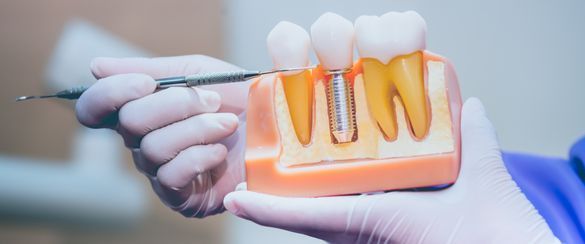Placement of dental implants in Lugano

Implantology in Lugano
Dental implantology refers to that set of surgical techniques designed to functionally rehabilitate a patient suffering from total or partial edentulism through the use of titanium dental implants, surgically inserted into the mandibular or maxillary bone
The implants in turn allow the connection of prostheses, fixed or removable, in order to restore masticatory function.
Currently, the implants most commonly used are the endosseous screw type, in most cases left submerged under the gingiva for a period ranging from two to five months depending on the type of technique and protocol used.
The most commonly used material in the production of implants is titanium, a biocompatible material that does not cause adverse reactions in the body (popularly but erroneously known as rejection).The implants are positioned in the patient’s bone and firmly incorporated in it by the physiological mechanism of bone regeneration; i.e. osseointegration. For more than 30 years, we have relied on Staumann, the world leader in the field of dental implants and the company that invests the most in research.The reliability and the possibility of sourcing replacement material even decades after a job had been completed is the major reason why we chose to rely on this company that has always satisfied our patients.
Implant surgery requires careful planning by the dentist, who can in most cases carry out a treatment plan simply using models, endoral x-rays and panoramic radiography.
In more complex cases, 3D radiography (three-dimensional digital volumetric tomography) will allow better evaluation of the risks and the successful options for adequate prosthetic rehabilitation.
This type of examination allows precise visualisation of the bone availability and finding the anatomical structures to be taken into account during the surgery.
It is also possible to position the implants in advance using computer modelling, which gives a precise idea of how they will be situated in the patient's mouth.This is a major advantage in terms of safety.Positioning an implant requires a time interval of between 30 and 60 minutes, depending on the type of intervention.It is made under local anaesthesia and is absolutely painless.After 10 days, the sutures are removed and after a period of osseointegration of about 10 weeks, the implant is ready to receive a ceramic crown.


